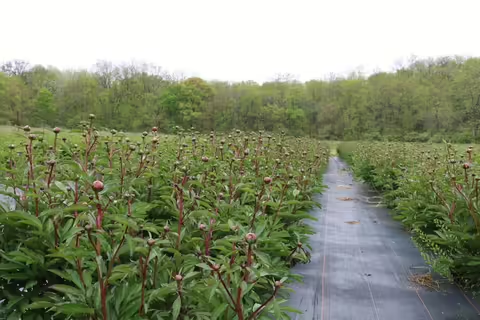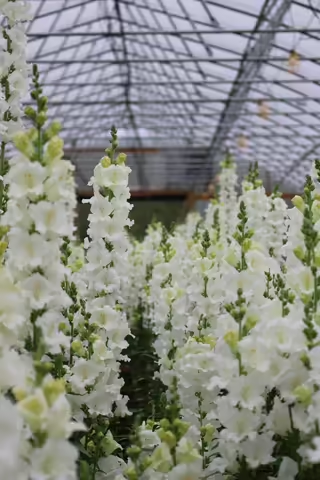When I want to get inspired by my work with local small farmers, I make my way to Clara Joyce Flowers. There, farmer Drew Groezinger inevitably has something new going on.
My visits have coincided with high tunnels being erected, a field of newly planted hemp, propagation houses busting at the seams with trays ready to be planted, preparation for social media launches, the creation of value-added products, and an innovative evolution of a farmstand. In my years of these ‘drop-ins’, the most dramatic change is the transition from colorful fields of vegetables to cascading seas of dahlias, ranunculus, sunflowers, peonies, and other specialty cut flowers.
To understand Clara Joyce Flowers and the work that Drew and his team do is to first understand that it was not “always flowers but it was always going to be flowers.”
As a seventh-generation resident of Jo Daviess County in the Driftless Region of Northwest Illinois, Drew grew up surrounded by rolling hills of farmland and family members who tilled the very same soil type Drew is growing in. He was supported by a grandmother who he sowed those initial seeds with 4-H projects that let him explore horticulture to determine his direction, a family business that enriched his customer service skills, and a community that proudly pushed him forward with values and principles that are with him each day he walks his fields.
The Shift from Vegetables to Cut Flowers
Clara Joyce Flowers has a quick timeline. At the age of 11, Drew decided to garden, which led to the development of Groezinger Produce Farm where he sold produce at local farmers markets and a CSA. It was his first planting of dahlias around 2015 that helped him to start envisioning what Clara Joyce Flowers would be. By 2017, he decided to go all-in by planting “6,000 dahlias and 400 peonies and blocks and blocks of annuals.”
Today, he grows on 9 acres of open field space, 20,000 square feet of greenhouses “with something always growing” including full-time employees and crucial wholesale partnerships.
Flowers and vegetables can be different in their needs. While both may have similar soil needs and disease and insect pests, cut flower production means a shift toward aesthetic instead of edible in which appearance is everything. While misshapen, imperfect vegetables may be sold in a local market, the same standards do not hold true for cut flowers.
In making this shift, knowing your customers for specialty cut flowers, such as florists, wholesale, bridal, or farmers markets, can take time. As Drew began building and fostering relationships with his clients, he was also bringing hist attention to detail and design experience working with local florists while in high school. This enriched his operation as he could now match up the flowers he was to grow and the customers he wanted to pursue.
While the labor, crop scheduling, and growing are all skills you need to have, you need to consider how to cater to a client's needs and their perspectives.
- Drew Groezinger
Cut Flower Grower to Grower Support and Education
As I have learned more about specialty cut flower growers and their industry, it’s become clear this is a grower-led movement in research, outreach, and education. This new wave of growers depends highly on one another to develop and enrich their grower community. It’s just not always in Illinois. These growers are creating valuable networks with each other around the United States, hours from each other, where they are supporting one another and training new cut flower growers.
One of the channels cut flower growers are building their community of direct education and support for one another is the photo-based social media platform Instagram which Drew identifies as a powerful outlet that provides “grower connections from all over” and “a network I rely on a lot.” These growers are sharing behind-the-scenes videos of daily tasks on their farms, making sales, connecting with brides and florists for weddings, and providing education and support for one another. The medium of Instagram, with its heavy focus on photos and videos, aligns well with cut flowers and their aesthetic qualities.
At the same time, the Association of Specialty Cut Flower Growers provides opportunities for new and established growers to connect with events, research, resources, mentorships, and scholarships.
This rise in new cut flowers growers has happened quickly since Drew started Clara Joyce Flowers.
“Finishing 2021, there are comfortable 15 to 16 people that are flower farmers 1 to 2 hours away from me. And that was not what it was when I started. Now there are flower farmers everywhere and now we have this community and network and recognition of people out there. So that if you need flowers, there are places to get beautiful, quality, and fresh products.”
Because of this community that Drew has become a part of, he wants to use his experience and knowledge to share with others. To do this, he has launched a podcast.
Each week on Between Me and Drew he covers many of those questions that new and established growers ask him about cut-flower production. As I have listened to these weekly episodes, it strikes me how passionate Drew is about providing support for someone getting started and encouraging them with bootstrapping, building and enhancing their community, and learning from mistakes.
More than One Person
It’s then not surprising based on how Drew talks about his flowers, farm, communities, and relationships, and what he has learned in growing and building his business, that it is ‘more than one person.'
“One of the biggest misconceptions about starting your farm or business is that you have to do it on your own," Drew Groezinger says. "When you do things on your own, you can have an insane amount of pride that can come in different ways or forms. But a farm, whether specialty crops, row crops, cut flowers, etc, a farm is fundamentally more than one person.”
MEET THE AUTHOR
Grant McCarty works with commercial and backyard growers and producers in Northwest Illinois by providing resources in fruit and vegetable production. His areas of expertise include soils management, organic/sustainable crop production, alternative crops, and general fruit and vegetable production. He helps local food system workers expand their operation, adopt new practices, read soil tests, and better manage their current production. Previous and current programs have focused on soil health, cover crops, fruit tree pruning, insect and disease management, hops, shiitake mushrooms, digital marketing, and many others.
ABOUT THE BLOG
Local Foods, Local Farms, Local People highlights Illinois specialty crop and livestock farmers all across the state who are changing the way we think about food and our relationship to it, one bite at a time. Our team and our blog cover everything from the humble beginnings of our growers, to details of sustainable production methods in the field, marketing challenges and successes, and everything in between. Through our investigations of these topics with the farmers of Illinois, we strive to improve local foods systems, access, and availability by sharing their collective knowledge with our readers.


